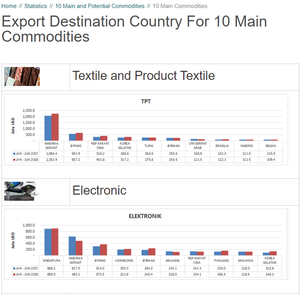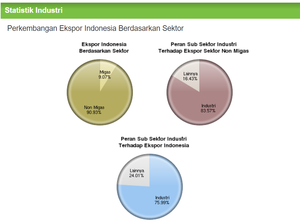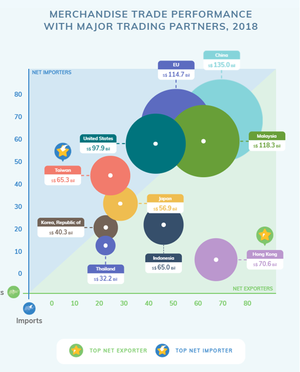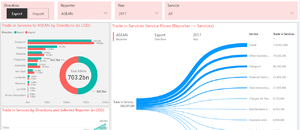<--- Go Back to Project Groups
PROBLEM & MOTIVATION
The Ministry of Trade (Kementrian Perdagangan Republik Indonesia) and Central Agency of Statistics (Badan Pusat Statistik) of Indonesia has been providing comprehensive Indonesia’s trading data. However, the information is mostly displayed in a table format. Hence, it is challenging to derive analysis and insights.
Our motivation is to address lack of a comprehensive visualization platform to show the impact of export and import on indonesia’s trade of balance. Furthermore, through this platform, users can essentially identify areas of deficit and improvement on the available data that Indonesia can work on.
It is important to do so because Indonesia is the 4th largest country in the world and one of the largest consumption markets at the global level. Export also has been the engine of Indonesia economy yet it has been declining steadily in 2012 due to lower commodity price and dwindling global demand. Moreover, now in 2019, Indonesia’s export has dropped by 9.99 percent as compared to 2018.
OBJECTIVE
From the comprehensive datasets readily available in the Central Agency of Statistics (over 85 data sets), we will focus on the 3 main objectives. It is as follows:
- Gain overall insights on the Export and Import activities in Indonesia by countries and regions since 2002. We will also identify the top trading partner of Indonesia.
- Identify the yearly trends of Exported and Imported Oil and Gas and Non Oil and Gas in Indonesia by countries. This would give us a better understanding on potential type of goods that Indonesia could focus on.
- Gain insights on the yearly trade balance trends to identify potential trading opportunity for Indonesia.
SELECTIVE DATABASE
The Data Sets we will be using for our analysis and for our application is listed below:
| Dataset/Source
|
Data Attributes
|
Rationale Of Usage
|
| Export Import
(1996 - 2019, July)
(https://www.kemendag.go.id/en/economic-profile/economic-indicators/indonesia-export-import)
|
- Year, Total, MIGAS (Oil and Gas), NON MIGAS (Non Oil and Gas), Sector: Agriculture, Sector: Industry, Sector: Mining, Sector: Others
- Year, Total, Consumption Good, Raw Material Support, Capital Goods.
|
The dataset will be used to understand the Indonesian Export and import figure from 1996 - 2019, July across multiple categories. At the end, we wish to spot the trend or pattern of Indonesia trading and economy situation.
|
|
Value of Exports by Major Countries of Destination (FOB value:million US$), 2000-2017
(https://www.bps.go.id/statictable/2014/09/08/1010/nilai-ekspor-menurut-negara-tujuan-utama-nilai-fob-juta-us-2000-2017.html)
Value of Imports by Major Countries of Origin (CIF value: million US$), 2000-2017
(https://www.bps.go.id/statictable/2014/09/08/1036/nilai-impor-menurut-negara-asal-utama-nilai-cif-juta-us-2000-2017.html)
|
- Year spanning from 2000-2017
- Year spanning from 2000-2017
|
The data set will be used to understand the export and import trading partner of Indonesia from year 2000-2017. We also will use this data set to identify the pattern of whether the import or export value is going up or down.
|
|
Value of Exports by Major Ports (FOB value: million US$), 2000-2017
(https://www.bps.go.id/statictable/2014/09/08/1008/nilai-ekspor-menurut-pelabuhan-utama-nilai-fob-juta-us-2000-2017.html)
Value of Imports by Major Ports (CIF value: million US$), 2000-2017
(https://www.bps.go.id/statictable/2014/09/08/1038/nilai-impor-menurut-pelabuhan-utama-nilai-cif-juta-us-2000-2017.html)
|
- Year spanning from 2000-2017
|
The data set will be used to understand the export and import major port of Indonesia from year 2000-2017.
|
|
Volume and Value of Indonesia Import and Export per Commodity
(https://www.bps.go.id/subject/8/ekspor-impor.html#subjekViewTab3)
|
- Country of destination
- Years
- Country of origin
- Years
|
The multiple data set will be used to look in detail the export or import value and volume per commodity to the or from Indonesian trading partners.
|
BACKGROUND SURVEY
We did basic background research on some existing visualizations or dashboards we could drive inspirations from or make it better. Below are a few visuals we found:
| Reference of Other Interactive Visualization
|
Learning Point
|
|
Title: Export Destination Country For 10 Main Commodities
Source: https://www.kemendag.go.id/en/economic-profile/10-main-and-potential-commodities/10-main-commodities
|
Positive Points:
- The bar graph shows the comparison of export in Jan-Jul 2017 to Jan-Jul 2018 for a specific commodity, e.g. Textile and Product Textile. It allows immediate comparison of export performance for the top trading partners of Indonesia.
Negative Points:
- There is no data label and it is hard to manually trace the graph to the figure.
- It only gives information in 2017 and 2018 from January to July
- There are no interactive tools that allow the user to choose the year or the commodities that they want to see
- The y-axis should start from 0 instead of a dash symbol
|
|
Title: Indonesia Growth of Export by Sector
Source: https://www.kemenperin.go.id/statistik/peran.php?ekspor=1
|
Positive Points:
- The first pie chart (yellow) shows the breakdown of Indonesian export by sector. It follows by the red and blue pie chart that shows further breakdown into percentage of non-oil and gas sector export. It gives the viewer more details and breakdown of Indonesia export.
Negative Points:
- It takes time and effort to understand the 3 pie charts at once.
- The use of the pie chart is not suitable to display the breakdown of export by sector. Instead, a stack bar chart can be used to show the total export and what made up of Indonesia export.
- Lack of Legend to show what goes inside the industry in the pie chart red and blue.
|
|
Title: Marchendise Trade Performance
Source: https://www.singstat.gov.sg/modules/infographics/singapore-international-trade
|
Positive Points:
- It shows the 2 information at once, which are merchandise trade value and the trading partners in 2018.
- Able to spot which the highest import and export trading partner clearly by the bubble position and its size.
Negative Points:
- The bubbles are overlapped yet the color use is opaque. It should use opacity so that the viewer will still be able to see the whole bubble.
- It is messy to cluster all elements on the graph (bubble + legend) and take a lot of time to make sense of the graph.
- Lack of interactive element and limited information as it only contain 2018 information. It would be better to include the filter so that the viewer is able to choose the year's input.
|
|
Title: ASEAN's Stat
Source: https://data.aseanstats.org/dashboard/tis
|
Positive Points:
- Interactive filter that gives choice for the viewer to filter the data that they want to see
- The toggle export and import allows the user to view both data on the same platform. It also helps the user to figure out the trade balance of service.
- The Trade in Services Service Flows (Reporter -> Services) graph is useful in showing the distribution contribution of service based on the quantity.
|
CONSIDERATION & VISUAL SELECTION




